|
|
|
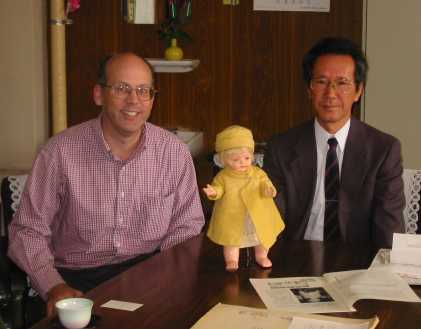
|

|
With Principal and School's
Blue-eyed Doll Named Mary
|
|
|
This school visit was arranged and supported by the members of the Miyagi
Blue-eyed Doll Study Group. The 30 members of this group has been very active
during the past two years in researching the history of the Blue-eyed Dolls
sent to Miyagi Prefecture, publishing the results of their work, and creating
classroom materials. For example, this summer three members of the group
published a 40-page article with photos in a journal published by the Sendai
Historical Museum. Now the group is busy with preparations for the homecoming
next spring of Miss Miyagi, the Japanese Friendship Doll sent to the U.S. in
1927 as a thank-you gift for the many Blue-eyed Dolls sent by American
children to Japan.
|
|
|
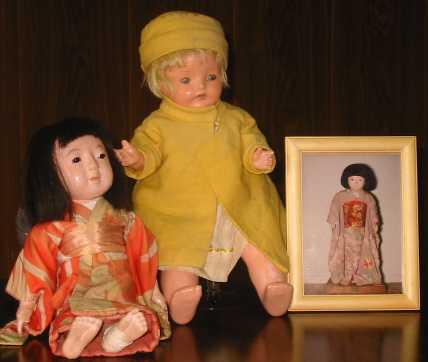
|
|
|
Japanese Ichimatsu Doll (left), Blue-eyed Doll
Named Mary (middle), and Japanese Friendship Doll Named Miss Miyagi (right)
|

|
|
|
The visit to Murata Daiyon Elementary School was my
fifth visit to a Miyagi Prefecture school that has a Blue-eyed Doll from
1927. Last November I had the opportunity to visit Monou
Elementary School, Sanbongi Elementary
School, Hirobuchi Kindergarten,
and Kawatabi Elementary School. Shuji
Satoh, who works at Miyagi Co-op in the promotion of cultural activities
throughout the prefecture, kindly took me by car to visit the schools both this
year and last year. Ken and Tomoko Shizukuishi let me stay in their large
traditional Japanese farmhouse built over 100 years ago, and I had the
opportunity to enjoy eating rice grown on their farm and oysters and cow's
tongue cooked over a fire. Mrs. Shizukuishi helped organize the visit to Murata
Daiyon Elementary School, and over the past year she and the Miyagi Blue-eyed
Doll Study Group have provided me with much information and many photos that I
have been able to use for my Friendship Dolls web site.
|
|
|
|
|
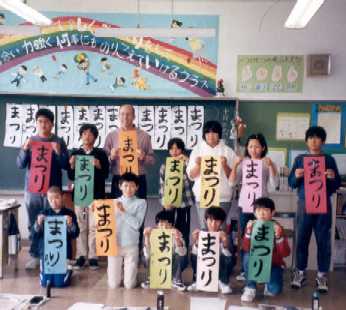
|

|
Showing Our Calligraphy
|
|
|
My visit at the school started in the office of
the principal, who showed me the school's Blue-eyed Doll named Mary and the
Japanese doll who kept her company during World War II when they were hidden
to prevent their destruction. The two dolls were discovered together in 1946
by the school's janitor Mr. Saito, and he took great care to preserve the two
dolls by sometimes putting mothballs inside their case and by airing out the
case from time to time. Now the two dolls are displayed in a special case in the
principal's office. A previous sixth-grade class made a cute sign that now
hangs outside the principal's office. The sign has drawings of the two
valuable dolls displayed in the office. The principal gave me a booklet about
the history of Mary.After my pleasant visit with the principal, I participated in a calligraphy
class for the 11 sixth-grade students where we had to write the three Japanese
characters for "ma-tsu-ri" or "festival." The teacher
selected this word because the town would celebrate a special festival in a
couple of days. This class was only my second attempt to draw Japanese
characters with brush and ink, so I quickly produced many practice sheets that
ended up in the trash. At the end of the class, each person's best work was
displayed on the board in front. I was happy at the end of this frustrating
but fun class that my work of calligraphy seemed to fit in quite well with the
students' works.
|
|
|
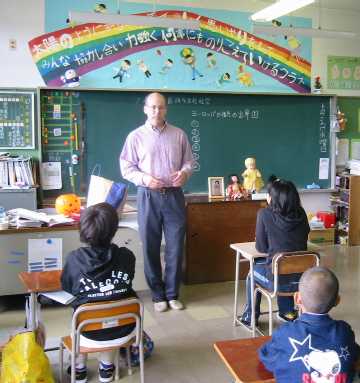
|
|
|
Talking with 6th-grade students
|

|
|
|
The main topic of the next hour's class with the
sixth-grade students was the history of the Friendship Dolls. We started by
watching a 10-15 minute video the school had produced on the history of Mary.
This well-done video, which had been created just a few years before, mentioned
that only four Blue-eyed Dolls remained in Miyagi Prefecture even though over
200 had been received in 1927. The students were quite surprised when they
found out that four more dolls had been found since the time the video was
created. Mrs. Shizukuishi explained the efforts of the Miyagi Blue-eyed Doll
Study Group to find the dolls by contacting many of the original schools that
received dolls and then meeting with older people who were at the
schools in 1927 when the dolls had been received. Next I tried to answer
several questions from the students and the teacher about the Friendship Dolls,
and then I presented to the students Miss Miyagi's photo, which was a gift
from Margaret Corbet, a woman living in Kansas who has owned the doll for about
20 years. I read the following letter to the class:
|
|
|
|
|
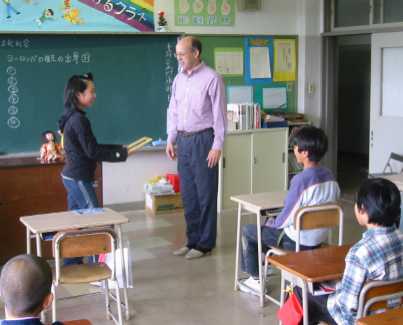
|

|
Student Representative Receiving
Framed Photo of Miss Miyagi
|
|
|
To Everyone at Murata Daiyon
Elementary School:
Thank you very much for giving
this beautiful Ambassador Doll in 1927. Miss Miyagi came from Japan to Kansas
in 1928 as a Japanese-American Friendship Ambassador. Even now she delights
American children. This year Miss Miyagi, together with four other dolls such
as Miss Hokkaido and Miss Mie, were shown as sister Ambassador Dolls at a
special exhibit at a museum in Missouri, the state next to Kansas.
The American Blue-eyed Dolls
and the Japanese Ambassador Dolls are precious symbols of friendship and
peace. We want to always take good care of Miss Miyagi.
We would be delighted if you
would place Miss Miyagi's photo next to your school's Blue-eyed Doll.
Margaret Corbet and Bill Gordon
|
|
|
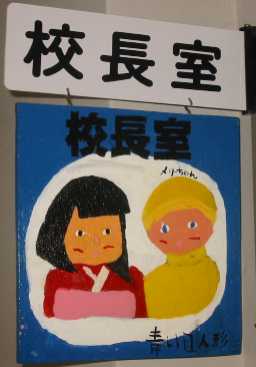
|
|
|
Doll Sign Hanging Outside of Principal's Office
|

|
|
|
During the next part of the class I explained to
the students that many Americans do not have blue eyes and white skin like the
Blue-eyed Dolls given by American children to Japan in 1927. The ancestors of
Americans came from countries all over the world, and even today the United
States has many immigrants from Asia, Mexico, and South America. We also
briefly discussed America's history of discrimination and prejudice against
African Americans, Native Americans, and other groups of people.
Most Japanese elementary school students eat lunch in their classrooms, but
all 56 students at Murata Daiyon Elementary eat together, probably due to the
small size of the school. In the early afternoon, the sixth-grade students used
the gymnasium to practice a beautiful traditional Japanese dance with swords
(not real of course).
A camera crew from a local TV station greeted me when I entered the school
and continued with me throughout the morning. I forgot about them when talking
to others, but it was nerve-wracking when the camera focused on my clumsy
attempts to write Japanese characters with brush and ink. Also, I was a little
startled when I was in the middle of talking to the sixth-grade class when they
asked me if it were OK to interview two or three students. The rest of us took
a break during this time, and I showed them a Halloween pumpkin mask and
distributed some wrapped Halloween chocolates in shapes such as Frankenstein,
ghosts, and Dracula.
|
|
|
|
|
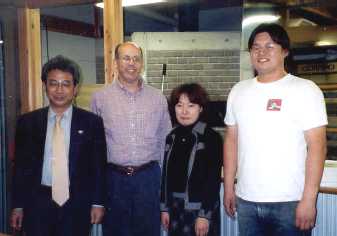
|

|
With Master Pizza Chef (far
right), Mrs. Shizukuishi (second from right), and Mr. Satoh from the Miyagi
Co-op (far left)
|
|
|
At the end of the day, the principal gave me a
special doll named Hotei-sama, which is made in the town of Murata.
Hotei-sama is one of the Seven Gods of Fortune, and Murata Town celebrates
Hotei Festival near the end of October. The sixth-grade
teacher is a big fan of Doraemon, a cat-shaped robot from the 22nd century who
can pull all sorts of secret tools out of his "Fourth Dimensional
Pocket" on his tummy whenever a boy named Nobita needs them to get
himself out of trouble. She gave me a couple of Doraemon comic books printed
with dialogue in both Japanese and English. In the trains and subways in and
near Tokyo, I had to stand most of the time, so I passed the time reading
these comic books, which I completed even before I left Japan.
Although the main purpose of going to Miyagi was to visit Murata Daiyon
Elementary School, there were several other highlights:
Pizza - We went to a pizza and bread restaurant connected with a community
center for handicapped people. Maybe I had been eating Japanese food for too
many days in a row, but this pizza was the best I have ever had in my life.
The pizza was cooked in a large brick oven over a fire, and I also added some
of the "spicy oil" available at each table. The restaurant workers
were very friendly, and they even came out of the restaurant and waved and
bowed as we were leaving in the car. At breakfast the next morning I savored
some of the bread from the restaurant.
|
|
|
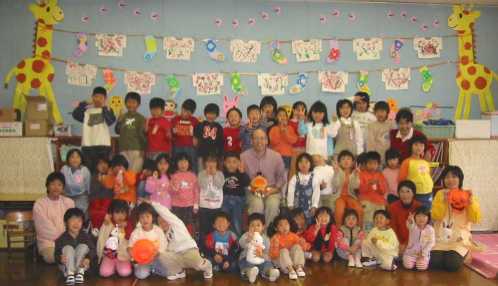
|
|
With Children and Teachers
at Miake Kindergarten
|

|
|
|
Miake Kindergarten - I made a brief stop at a kindergarten near Mr. and
Mrs. Shizukuishi's house to talk about American greetings and Halloween.
Afterwards we had fun washing sweet potatoes, some of which were gigantic, in
three large tubs of water outside.Matsushima -
The view from the coast of Matsushima, a short distance from Miyagi's capital
of Sendai, is one of the three most famous scenic views in Japan. However, we
stopped by in the evening, so we could not see very much.
Local Beer - I tried a bottle of
locally-brewed beer, which tasted quite delicious and had a distinct banana
flavor (at least to me). In comparison to the U.S., the variety of local beers
in Japan is limited, and usually these beers have a high price tag, about $5
for a regular bottle.
|
|
|
|
|
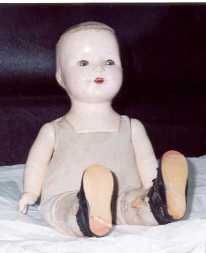
|

|
Doll at Marumori Library
|
|
|
Doll at Marumori Library - The locked safe at the
library of the small town of Marumori contains one of the eight Blue-eyed
Dolls that have been found in Miyagi Prefecture. This doll is in sorry shape
now, with no hair and a hole in the top of its head. The doll has no clothing
other than its undergarments and shoes.Marumori Town Office -
After the visit to Murata Daiyon Elementary, we stopped at the Town Office of
Marumori to meet Mr. Iwao Sato, who had a great deal of information about the
Friendship Dolls that he let Mrs. Shizukuishi have for her research about the
dolls of Miyagi Prefecture. He gave me a book about Ujo Noguchi, who wrote the
song "Blue-eyed Doll,"
which became the term used in Japan for each of the 12,739 dolls sent by America to
Japan in 1927. The book contains the stories behind the many children's songs
written by Ujo Noguchi, and there is also a CD with his songs.
Package from Kagawa - After I arrived in
Miyagi Prefecture at the Sendai train station, we drove to the Sendai
Historical Museum, where the Miyagi Blue-eyed Doll Study Group holds their
regular meetings. The museum curator, who I had met in my prior year visit,
gave me a surprise package from Tatsuya Matsuda, who lives in Kagawa
Prefecture and who I have never met before. The package contained much
material about the Blue-eyed Dolls, including many photos of three Blue-eyed
Dolls in Kochi, Ehime, and Hyogo Prefectures.
Cow's Tongue - Cow's tongue is one of
the specialties of the city of Sendai, and you can even buy a box lunch at the
train station with cow's tongue in it. I ate some delicious cow's tongue twice
during my visit. On the night of my arrival, we had cow's tongue cooked over a
fire at the home of the Shizukuishi family. As I was leaving Miyagi, we also
ate at a cow's tongue restaurant across from the train station. We entered the
restaurant before noon so we only had to wait less than five minutes, but
while we were eating, a line formed outside the restaurant. About 20 people
were standing in the rain waiting to eat Sendai's delicious specialty.
|
|
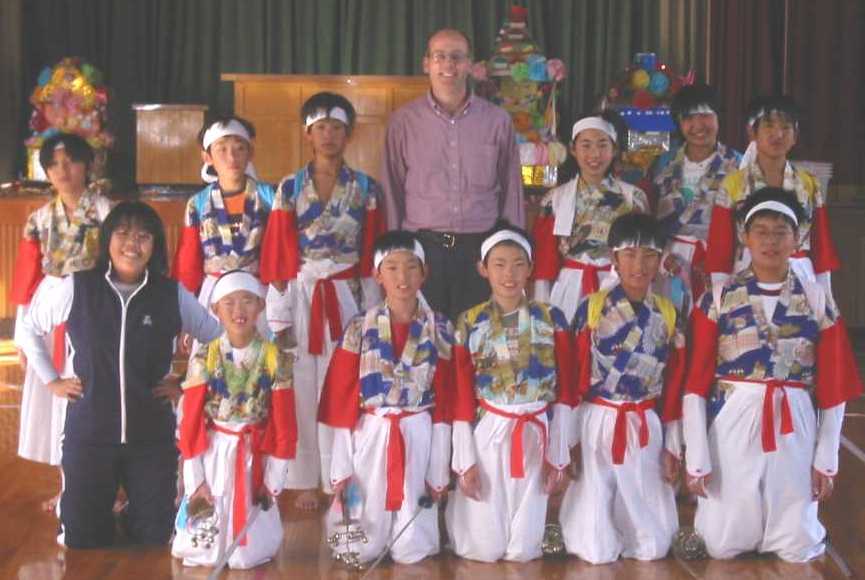
Sixth Graders in Attire for Traditional Japanese
Dance
|
|
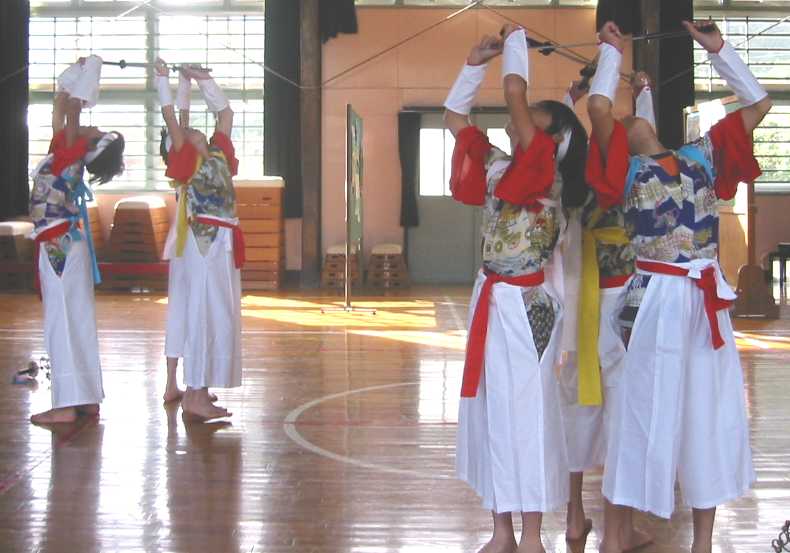
Practicing Traditional Japanese Dance with Swords
|
|
|